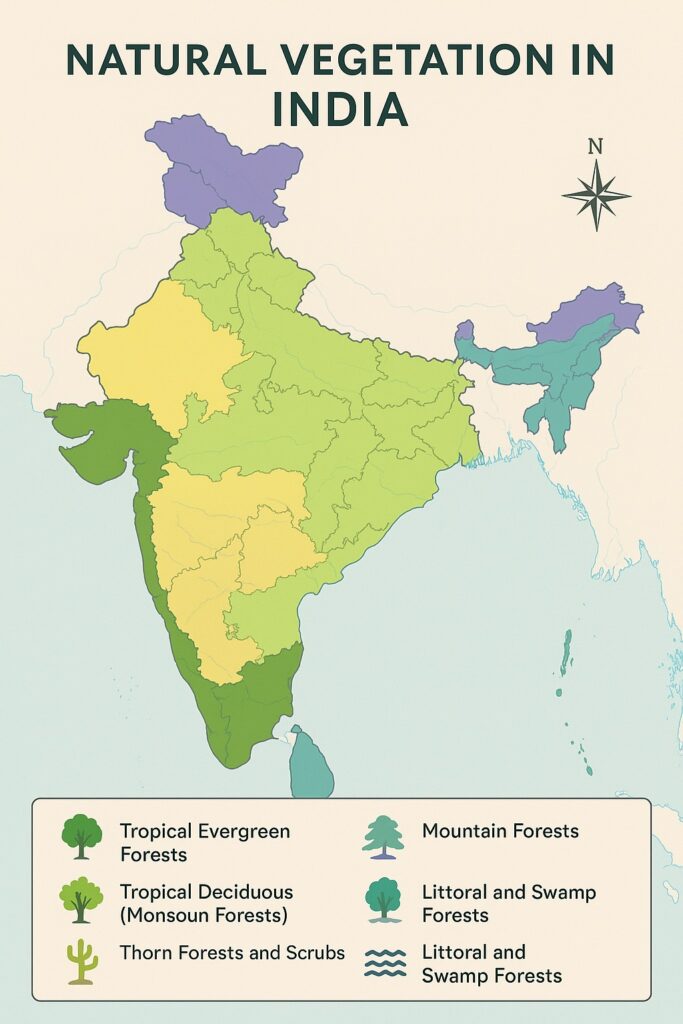India, due to its vast geographical expanse and diverse climatic conditions, possesses a wide variety of natural vegetation. Natural vegetation refers to plant life that grows naturally in a region without human intervention. It reflects the ecological balance and climatic conditions of a place. The richness and diversity of vegetation in India are influenced by factors like temperature, rainfall, soil types, and altitude.

Table of Contents
Major Types of Natural Vegetation in India
- Tropical Evergreen Forests
- Location: Found in areas with heavy rainfall (more than 200 cm annually) such as the Western Ghats, Andaman and Nicobar Islands, and parts of Northeast India.
- Characteristics: Dense, multi-layered forests with a rich variety of flora and fauna. Trees remain green throughout the year.
- Important Species: Ebony, mahogany, rosewood, rubber, and bamboo.
- Tropical Deciduous Forests (Monsoon Forests)
- Location: Widely spread across central and northern India, including Madhya Pradesh, Uttar Pradesh, Chhattisgarh, and Jharkhand.
- Characteristics: These forests shed their leaves during the dry season to conserve water. They are the most widespread forests in India.
- Important Species: Sal, teak, sandalwood, bamboo, and arjun.
- Thorn Forests and Scrubs
- Location: Found in arid and semi-arid regions like Rajasthan, Gujarat, and parts of Deccan plateau.
- Characteristics: Trees are short, with thick bark and long roots. Vegetation is sparse and adapted to dry conditions.
- Important Species: Cactus, acacia, date palm, and khejri.
- Montane Forests
- Location: Found in the Himalayan region, varying with altitude.
- Characteristics:
- Lower altitudes (1000–2000 m): Sub-tropical forests with trees like oak and chestnut.
- Higher altitudes (2000–3000 m): Temperate forests with coniferous trees.
- Alpine zone (>3000 m): Alpine vegetation such as mosses and lichens.
- Important Species: Pine, fir, deodar, spruce, and rhododendron.
- Mangrove Forests
- Location: Coastal regions and river deltas like the Sundarbans (West Bengal), Mahanadi, Krishna, and Godavari deltas.
- Characteristics: Salt-tolerant plants with stilt-like roots adapted to tidal waters.
- Important Species: Sundari tree (dominant in Sundarbans), coconut, and palm.
Importance of Natural Vegetation
- Ecological Balance: Helps maintain climate stability and soil health.
- Biodiversity: Supports a wide variety of wildlife species.
- Economic Value: Provides timber, fuel, fodder, medicinal plants, and raw materials for various industries.
- Cultural and Spiritual Significance: Many plant species are revered in Indian traditions and used in religious rituals.
Threats to Natural Vegetation
- Deforestation due to agriculture, urbanization, and industrialization.
- Forest fires and overgrazing.
- Climate change and pollution.
Conservation Efforts
- Creation of national parks, wildlife sanctuaries, and biosphere reserves.
- Afforestation and reforestation programs.
- Government initiatives like the National Afforestation Programme (NAP) and Green India Mission.
Conclusion
India’s natural vegetation is a vital component of its environmental wealth and biodiversity. Protecting and preserving it is crucial for ecological balance, sustainable development, and the well-being of future generations. Collective efforts from the government and citizens are essential to ensure the conservation of this precious natural heritage.
Read: Geography Notes